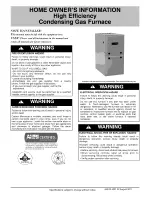
8
AIR FOR COMBUSTION AND
VENTILATION
Provisions for adequate combustion, ventilation, and dilution air
must be provided in accordance with:
S
U.S. installations: Section 9.3 of the NFGC, Air for
Combustion and Ventilation, and applicable provisions
of the local building codes.
S
Canadian installations: Part 7 of the NSCNGPIC, Vent-
ing Systems and Air Supply for Appliances, and all
authorities having jurisdiction.
FURNACE CORROSION HAZARD
Failure to follow this caution may result in furnace damage.
Air for combustion must not be contaminated by halogen
compounds, which include fluoride, chloride, bromide, and
iodide. These elements can corrode heat exchangers and
shorten furnace life. Air contaminants are found in aerosol
sprays, detergents, bleaches, cleaning solvents, salts, air
fresheners, and other household products.
CAUTION
!
CARBON MONOXIDE POISONING HAZARD
Failure to follow this warning could result in personal
injury or death.
The operation of exhaust fans, kitchen ventilation fans,
clothes dryers, attic exhaust fans or fireplaces could create a
NEGATIVE PRESSURE CONDITION at the furnace.
Make--up air MUST be provided for the ventilation devices,
in addition to that required by the furnace. Refer to Carbon
Monoxide Poisoning Hazard warning in venting section of
these instructions to determine if an adequate amount of
make--up air is available.
!
WARNING
The requirements for combustion and ventilation air depend
upon whether or not the furnace is located in a space having a
volume of at least 50 cu/ft. per 1,000 Btuh input rating for all gas
appliances installed in the space.
S
Spaces having less than 50 cu/ft. per 1,000 Btuh re-
quire the OUTDOOR COMBUSTION AIR
METHOD.
S
Spaces having at least 50 cu/ft. per 1,000 Btuh may use
the INDOOR COMBUSTION AIR, STANDARD or
KNOWN AIR INFILTRATION METHOD.
Outdoor Combustion Air Method
1. Provide the space with sufficient air for proper combus-
tion, ventilation, and dilution of flue gases using perman-
ent horizontal or vertical duct(s) or opening(s) directly
communicating with the outdoors or spaces that freely
communicate with the outdoors.
2. Fig. 7 illustrates how to provide TWO OUTDOOR
OPENINGS, one inlet and one outlet combustion and
ventilation air opening, to the outdoors.
a. One opening
MUST
commence within 12 in. (300
mm) of the ceiling and the second opening
MUST
commence within 12 in. (300 mm) of the floor.
b. Size openings and ducts per Fig. 7 and Table 2.
c. TWO HORIZONTAL DUCTS require 1 sq./in. of free
area per 2,000 Btuh (1,100 mm2/kW) of combined
input for all gas appliances in the space per Fig. 7 and
Table 2.
d. TWO OPENINGS OR VERTICAL DUCTS require 1
sq./in. of free area per 4,000 Btuh (550 mm2/kW) for
combined input of all gas appliances in the space per
Fig. 7 and Table 2.
3. ONE OUTDOOR OPENING requires:
a. 1 square inch of free area per 3,000 Btuh (734
mm2/kW) for combined input of all gas appliances in
the space per Table 2 and
b. Not less than the sum of the areas of all vent connect-
ors in the space.
The opening shall commence within 12 in. (300 mm) of the
ceiling. Appliances in the space shall have clearances of at least 1
in. (25 mm) from the sides and back and 6 in. (150 mm) from the
front. The opening shall directly communicate with the outdoors
or shall communicate through a vertical or horizontal duct to the
outdoors or spaces (crawl or attic) that freely communicate with
the outdoors.
Indoor Combustion Air
NFPA & AGA
Standard
and
Known--Air--Infiltration Rate
Methods
Indoor air is permitted for combustion, ventilation, and dilution,
if the
Standard
or
Known--Air--Infiltration Method
is used.
CARBON MONOXIDE POISONING HAZARD
Failure to follow this warning could result in death and/or
personal injury.
Many homes require air to be supplied from outdoors for
furnace combustion, ventilation, and dilution of flue gases.
The furnace combustion air supply must be provided in
accordance with this instruction manual.
!
WARNING
The
Standard
Method:
1. The space has no less volume than 50 cu/ft. per 1,000
Btuh of the maximum input ratings for all gas appliances
installed in the space and
2. The air infiltration rate is not known to be less than 0.40
air changes per hour (ACH).
The
Known Air Infiltration Rate
Method shall be used, if the
infiltration rate is known to be:
1. Less than 0.40 ACH and
2. Equal to or greater than 0.10 ACH
Infiltration rates greater than 0.60 ACH shall not be used. The
minimum required volume of the space varies with the number of
ACH and shall be determined per Table 3 or Equations 1 and 2.
Determine the minimum required volume for each appliance in
the space and add the volumes together to get the total minimum
required volume for the space.
PG
8J
/M








































